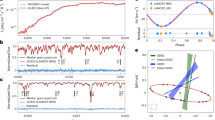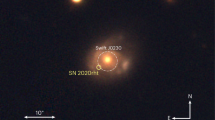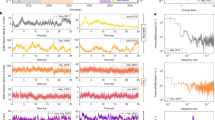Abstract
USING data from the Ginga satellite, Done et al.1 have confirmed an Exosat observation2 of high-amplitude periodic modulation in the X-ray emission from the Seyfert galaxy NGC6814. To within observational errors of ∼1%, the period seems to have remained constant at ∼12,100 seconds between 1985 and 1989. An obvious candidate for the phenomenon underlying the periodicity is the orbital motion of a star or low-mass compact object around the central black hole3. As we show here, the presence of an orbiting star could be verified easily by looking for the effects of Lense–Thirring precession of the orbital plane, caused by the dragging of inertia! frames around a rotating black hole. Precession-induced variations in the waveform and in the phase of the observed periodicity should have a period of between a month and a year. Such variations could account for the different waveforms present in the Ginga and Exosat data sets4, and may be detectable in existing Ginga and future Rosat, OSSE/GRO, and Astro-D data.
This is a preview of subscription content, access via your institution
Access options
Subscribe to this journal
Receive 51 print issues and online access
$199.00 per year
only $3.90 per issue
Buy this article
- Purchase on SpringerLink
- Instant access to full article PDF
Prices may be subject to local taxes which are calculated during checkout
Similar content being viewed by others
References
Done, C. et al. in Structure and Emission Properties of Accretion Disks (eds Bertout, C., Collin-Souffrin, S., Lasota, J.-P. & Tran Thanh Van, J.) 417–418 (Editions Frontieres, Gif sur Yvette, 1991).
Mittaz, J. P. D. & Branduardi-Raymont, G. Mon. Not. R. astr. Soc. 238, 1029–1046 (1989).
Syer, D., Clarke, C. J. & Rees, M. J. Mon. Not. R. astr. Soc. 250, 505–512 (1991).
Done, C. et al. in Testing the AGN Paradigm (eds Urry, C. M., Neff, S. & Holt, S.) (AIP Conf. Proc. Series, in the press).
Done, C. et al. in Frontiers of X-ray Astronomy (eds Tanaka, Y. & Koyama, K.) (Universal Academy Press, Tokyo, in the press).
Bardeen, J. M. & Petterson, J. A. Astrophys. J. 195, L65–67 (1975).
Lense, J. & Thirring, H. Physik. Z. 19, 156–163 (1918).
Wilkins, D. C. Phys. Rev. D 5, 814–822 (1972).
Shakura, N. I. & Sunyaev, R. A. Astr. Astrophys. 24, 337–355 (1973).
Tout, C. A., Eggleton, P. P., Fabian, A. C. & Pringle, J. E. Mon. Not R. astr. Soc. 238, 427–438 (1989).
MacDonald, J., Stanev, T. & Biermann, P. L. Astrophys. J. 378, 30–38 (1991).
Czerny, M., Sikora, M. & Begelman, M. C. in Relativistic Hadrons in Cosmic Compact Objects (eds Zdziarski, A. A. & Sikora, M.) 23–25 (Springer, Heidelberg, 1991).
Kunieda, H. et al. in Iron Line Diagnostics in X-ray Sources (ed. Treves, A.) (Springer, Berlin, in the press).
Author information
Authors and Affiliations
Rights and permissions
About this article
Cite this article
Sikora, M., Begelman, M. Does an orbiting star cause periodic modulation of X-rays from NGC6814?. Nature 356, 224–225 (1992). https://doi.org/10.1038/356224a0
Received:
Accepted:
Issue date:
DOI: https://doi.org/10.1038/356224a0
This article is cited by
-
Nonlinear optical characterization of colloidal solutions containing dye and Ag2S quantum dot associates
Applied Physics A (2016)
-
Large third order optical nonlinearity and optical limiting properties of a 3,4-diaminopyridine
Journal of Materials Science: Materials in Electronics (2015)
-
Novel Organically Templated 2-D Silver(I)-Iodide Coordination Architecture: Syntheses and Characterization
Journal of Cluster Science (2006)
-
Solving the mystery of the X-ray periodicity in the Seyfert galaxy NGC6814
Nature (1993)
-
Variability of the central region in active galactic nuclei
The Astronomy and Astrophysics Review (1992)



